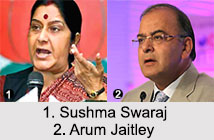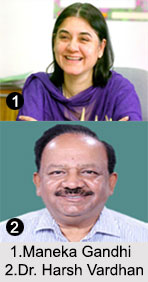 Cabinet Ministers of India are responsible for the execution and administration of laws, as per the Constitution of India. They are also termed as collective decision-making body of the Government of India, commonly known as Central Government and officially referred as the Union Government. These ministers are appointed by the President on the advice of the Prime Minister, following Article 75 of the Indian Constitution. It is obligatory for the Cabinet Ministers to be the members of either house of the Parliament. They are also authorized by the Constitution of India to be members of either house of the Parliament, which comprises of the President, Rajya Sabha and Lok Sabha. Both the houses of Parliament give consents to all the governance. However, the will of the Lok Sabha always endures in case of money bills. The ministers are based in offices of their respective Union Ministries in New Delhi.
Cabinet Ministers of India are responsible for the execution and administration of laws, as per the Constitution of India. They are also termed as collective decision-making body of the Government of India, commonly known as Central Government and officially referred as the Union Government. These ministers are appointed by the President on the advice of the Prime Minister, following Article 75 of the Indian Constitution. It is obligatory for the Cabinet Ministers to be the members of either house of the Parliament. They are also authorized by the Constitution of India to be members of either house of the Parliament, which comprises of the President, Rajya Sabha and Lok Sabha. Both the houses of Parliament give consents to all the governance. However, the will of the Lok Sabha always endures in case of money bills. The ministers are based in offices of their respective Union Ministries in New Delhi.
Functions of Cabinet Ministers of India
A number of Union Ministries and Departments have been created by the Indian Parliament for the greater interest of dealing with specific areas of national and international affairs. The advancement of Union Ministries depends on the Cabinet Ministers of India. A minister carries out "expeditious implementation" of government policies, plans and programmes, pertaining to his ministry. Ministers act as advisors to the President. They are responsible for increasing the security of the country, improving India"s foreign affairs and keeping the country"s economy in a superior state. Cabinet Ministers of India act in advisory and funding capacity, when dealing with matters which are deputed to the states.
Present Cabinet Ministers of India
In 2014 general election, Bratiya Janata Party (BJP) turned out to be victorious. As of July, 2017, the BJP government, led by Prime Minister, Narendra Modi is governing 18 states of India. The Cabinet Ministers of India and their respective Ministries are given below:
•Rajnath Singh (Ministry of Home Affairs)
•Sushma Swaraj (Ministry of External Affairs and Ministry of Overseas Indian Affairs)
•Arun Jaitley (Ministries of Finance and Corporate Affairs)
•Nitin Jairam Gadkari (Ministries of Road Transport and Highways, Shipping, Water Resources, River Development and Ganga Rejuvenation)
•Suresh Prabhu (Ministry of Commerce and Industry)
•D.V. Sadananda Gowda (Ministry of Statistics and Programme Implementation)
•Uma Bharati (Ministry of Drinking  Water and Sanitation)
Water and Sanitation)
•Ram Vilas Paswan (Ministry of Consumer Affairs, Food and Public Distribution)
•Maneka Gandhi (Ministry of Women and Child Development)
•Ananth Kumar (Ministries of Chemicals and Fertilizers and Parliamentary Affairs)
•Ravi Shankar Prasad (Ministries of Law and Justice and Electronics and Information Technology)
•Jagat Prakash Nadda (Ministry of Health and Family Welfare)
•Ashok Gajapathi Raju (Ministry of Civil Aviation)
•Anant Geete (Ministry of Heavy Industries and Public Enterprises)
•Harsimrat Kaur Badal (Ministry of Food Processing Industries)
•Narendra Singh Tomar (Ministries of Rural Development, Panchayati Raj and Mines)
•Chaudhary Birender Singh (Ministry of Steel)
•Jual Oram (Ministry of Tribal Affairs)
•Radha Mohan Singh (Ministry of Agriculture and Farmers Welfare)
•Thaawar Chand Gehlot (Ministry of Social Justice and Empowerment)
•Smriti Irani (Ministries of Textiles and Information and Broadcasting)
•Dr Harsh Vardhan (Ministries of Science and Technology, Earth Sciences and Environment, Forest and Climate Change)
•Prakash Javadekar (Ministry of Human Resource Development)
•Dharmendra Pradhan (Ministries of Petroleum and Natural Gas and Skill Development and Entrepreneurship)
•Piyush Goyal (Ministries of Railways and Coal)
•Nirmala Sitharaman (Ministry of Defence)
•Mukhtar Abbas Naqvi (Ministry of Minority Affairs)
Apart from the Cabinet Ministers of India, there are two other categories of ministers in the country. They are the Ministers of State (MoS) and Ministers of State with Independent Charge.
The Union Cabinet Ministers hold the highest rank among the three categories of ministers in India.




















